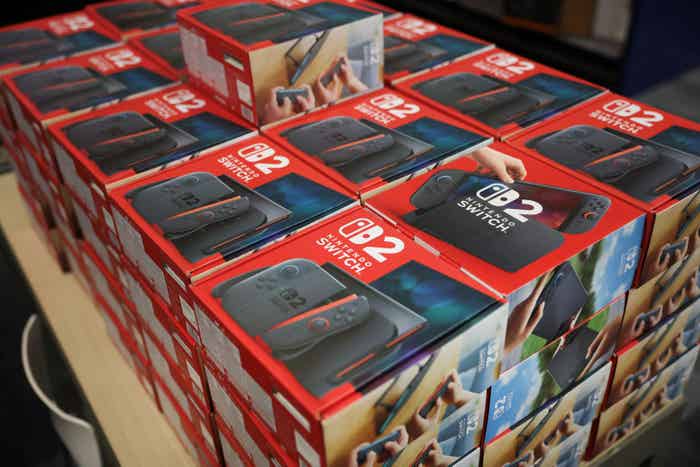This story was reported in collaboration with Provide Chain Dive, an award-winning publication for information and tendencies shaping provide chain administration.
When Nintendo unveiled particulars about its extremely anticipated Swap 2 console on April 2, little did it know the day can be a turning level in international commerce.
Simply hours after the sport trade large confirmed off the successor to its hit Swap console, President Donald Trump laid out plans to implement common reciprocal tariffs.
Trump referred to as for a baseline tariff of 10% and better duties on quite a few nations, instantly sowing uncertainty for the June 5 launch of the Swap 2.
Japan-based Nintendo at the moment produces a lot of its U.S.-bound items in Vietnam, with another manufacturing in China, based on Daniel Ahmad, director of analysis and insights at Niko Companions.
Underneath the Trump administration’s authentic reciprocal tariffs announcement, imports from Vietnam would have been hit with a 46% tariff underneath Trump’s authentic reciprocal tariffs — among the many highest charges of any nation.
Since Trump’s announcement, the U.S. paused some duties and offered exemptions for sure product classes, even reaching a 90-day truce with China, which at one level confronted tariff charges of at the very least 145%. Whereas the 2 nations have since reached the framework of a deal, imports from China would nonetheless be topic to 55% tariffs underneath the proposed pact, Trump stated earlier this month.
Amid the turmoil, Nintendo went by with its June 5 launch date. Nevertheless it begs the query: How have fluctuating commerce relationships impacted the corporate’s U.S. rollout? And what challenges would possibly it face sooner or later?
A managed launch
Regardless of a couple of non-tariff associated hiccups, the preliminary rollout of the Swap 2 has been profitable, promoting greater than 3.5 million items its first 4 days available on the market, based on Nintendo.
Many consoles had been secured by way of pre-order, regardless of Nintendo initially delaying them in response to the brand new tariffs unveiled by the Trump administration in early April. The pause — which the corporate lifted April 24 — was a short-term play, nonetheless.
“Simply pausing pre-orders, however not doing anything, simply buys you time to watch,” stated Joseph Fitzgerald, managing director and accomplice at Boston Consulting Group.
Though Nintendo went full steam forward with its plans following the pre-order pause, many shopper items corporations have been taking extra long-term wait-and-see approaches to tariffs, with some stockpiling stock to delay extra drastic actions.
It’s unclear how Nintendo dealt with the preliminary tariff shock past the pause, as the corporate didn’t reply to a request for remark. Nevertheless, based on Sally Peng, senior managing director and chief of export controls, sanctions and commerce for the Asia-Pacific area at FTI Consulting, it might have constructed up a certain quantity of Swap 2 stock forward of launch to make sure it may meet the preliminary rush.
Strategizing for the long run
There isn’t a fast repair to stave off the affect of tariffs for shopper electronics makers like Nintendo, nonetheless.
Simply shifting a single firm’s manufacturing operation can be difficult sufficient, based on Fitzgerald. It takes roughly 9 to 12 months to maneuver manufacturing to completely different geographies, he stated, and that’s simply the beginning. Firms usually need to be utilizing a facility for 5 to 10 years to be assured it will possibly meet demand and high quality requirements sufficiently for a tool just like the Swap 2, he added.
Regardless of the extent of complexity required to shift manufacturing, shopper electronics makers in North America are placing a variety of “energy” into rebalancing, Fitzgerald added. Places which can be receiving essentially the most consideration embrace Latin America, jap Europe and nations in Southeast Asia past China.
Transferring manufacturing to the U.S. is another choice, however problems stay even when an organization like Nintendo had been to spend money on such a transfer.
“You find yourself having to have this dialogue round, hey, are you able to additionally mirror our provide chain on this location, or are you going to proceed to offer from an outdoor america location, and what’s our price distinction?” Fitzgerald stated.
Relocating an organization’s personal manufacturing footprint is difficult sufficient. However sport console makers depend on hundreds of parts and coordinate with giant accomplice ecosystems to make gadgets that may be offered at consumer-friendly costs.
“That Tier 2, Tier 3 alignment in these places is basically the largest factor that’s underneath menace while you’re type of vacillating in coverage,” Fitzgerald stated.
The full provide chain prices of various tariff methods will decide which long-term gambits electronics producers make in response to a shifting international commerce setting. These line gadgets embrace procurement, logistics and labor prices, amongst others.
“So, if we take a look at all these three prices collectively and collectively as a landed price, it’ll be a lot more healthy to make your determination in instances of uncertainty, which is type of the understatement of the yr,” FTI’s Peng stated.
There may be some precedent for efficiently finishing such a provide chain retooling, based on Peng, who highlighted attire and footwear as a sector that’s forward of many different industries on this regard.
“Very a few years in the past, they already discovered that apart from labor prices, responsibility prices or tariff prices are an enormous a part of their whole price,” Peng stated.
The actual problem comes subsequent
Though Nintendo weathered the tariff onslaught in the course of the Swap 2’s launch, the actual take a look at for the console’s first yr lies within the months forward.
Like different shopper items makers, Nintendo might want to usher in orders in the course of the summer time’s peak transport season to arrange for vacation demand. Because of the present commerce setting, that may imply both rush ordering to make the most of the Trump administration’s present tariff reprieve or consuming greater transport prices when and if at the moment paused tariffs return into place.

Picture by Joe Raedle by way of Getty Pictures.
The vacation season drives {hardware} and software program gross sales for the online game trade. Gross sales within the fiscal quarter ending Dec. 31 accounted for 37% of Nintendo’s international gross sales in 2024, per Provide Chain Dive calculations. Roughly 60% of U.S. income for the corporate, which doesn’t publicly report regional earnings, comes from gross sales on the finish of the yr, former Nintendo of America President Reggie Fils-Aimé stated in 2018.
Nintendo is anticipating to promote 15 million items of the Swap 2 globally over the subsequent eight months. However to succeed in that mark, it should cope with a possible return of the Trump administration’s country-specific reciprocal tariffs subsequent month to satisfy its U.S. gross sales forecast.
Tariffs on imports from China have been lowered till mid-August whereas different country-specific duties are paused till early July. Even with the reprieve window, which has led to a pickup in shipments, imports are anticipated to drop 6.2% yr over yr in June and eight.1% YoY in July, per the Nationwide Retail Federation, with much more drastic reductions anticipated for the remainder of the yr.
Decreasing shipments as a result of greater tariffs or slower demand received’t create a silver lining of saved prices for Nintendo, although, based on Peng. New console rollouts are deliberate up to now upfront that the corporate doubtless already has the fabric to provide extra consoles, Peng stated. In the meantime, manufacturing in China and different nations in Southeast Asia focused by Trump’s tariffs has slowed down within the first half of 2025, she added.
“So, we’re not simply speaking about completed items not having the ability to ship. They already sunk a variety of prices into making ready the fabric or securing the fabric,” Peng stated.
Given the tariff-driven uncertainty, Nintendo and different shopper electronics makers are being compelled to make atypical selections throughout this time of yr.
“How aggressive do I am going by way of chasing these again orders? And do I solely plan to meet provide for, say, 30 days at a time, which inherently limits my max capability that I can fulfill,” Fitzgerald stated. “So any launch, I’d assume, has an extended backlog achievement interval as a result of corporations are going to inch alongside in that achievement course of as a result of uncertainty.”
The potential Nintendo benefit
Nintendo has remained assured in its skill to satisfy demand within the face of manufacturing challenges, whilst tariffs proceed to rankle provide chains. Whereas not resistant to duties given its manufacturing footprint in Vietnam and China, in addition to being a Japan-based firm, Nintendo holds a novel place within the online game trade.
Since Nintendo’s success with the Wii console, first launched in 2006, the corporate has damaged away from its main opponents (Microsoft and PlayStation) with a definite growth technique.
Over the past twenty years, Nintendo deprioritized processing speeds and graphical constancy for distinctive {hardware} mechanics similar to movement controls and portability. This strategy is a part of a extra family-focused product technique for Nintendo. In distinction, Microsoft and Sony proceed to primarily goal the 18-34 demographic.
Due to its technique — and its online game consoles typically— there’s a built-in demand safety, even when tariffs gasoline greater costs. Nintendo has dedicated to its initially introduced worth of $449 for the Swap 2, nevertheless it stated console equipment will expertise worth changes as a result of “adjustments in market circumstances.”
“Video video games are distinctive as a result of there’s solely one in every of that platform, proper? And also you’re probably not competing [with other businesses],” Fitzgerald stated. “They’re a class of 1 unto themselves.”
That is very true for Nintendo, whose best-selling first-party video games are unique to its console. Sony and Microsoft, in the meantime, have launched first-party titles on different platforms.
As well as, as a result of Nintendo’s console launch cadence shouldn’t be on the identical cycle as Xbox and Ps, which frequently launch new generations on the similar time. Due to this fact, it will possibly stand alone among the many large three console makers this yr.
Sport Developer and Provide Chain Dive are sibling organizations underneath Informa TechTarget.



